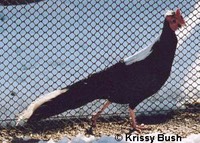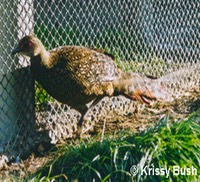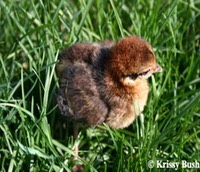Scientific Information
Class: Aves
Order: Galliformes
Family: Phasianidae
Subfamily: Phasianinae
Genus: Lophura
Species: Lophura swinhoei
Species English name: Swinhoe Pheasant
CITES Status: CITIES I - endangered
Distribution: Formosa
(from A Monograph of Pheasants Volumes I, II, III & IV, William Beebe)
Description
• Male - Metallic dark blue body, neck, wings, and tail. White patch on back surrounded on 3 sides by metallic purple patches. Middle two tail feathers are white and crest is white. Red wattles.
• Female - Body is a greyish brown with dark brown and golden cream markings. All of the golden cream markings are an arrow pattern. Middle tail feathers are body colour with brown barring and outer tail feathers on both sides are reddish brown. females posses a brown crest and the wattles are red.
Diet
• We feed our breeders and young adults 16% layer pellets, our tiny chicks 25% Turkey Starter crumble, and our growing chicks 20% crumble.
• They get a handful of mixed grains every second day except during breeding season, fresh greens (lettuce, chickweed, dandelions, grass) and fruits (tomato, grapes, berries, etc.) when available.
Breeding
• Done in pairs or trios.
• Swinhoe are usually first year birds. If the female was an early hatch the previous year, the female will lay eggs, but if she was a late hatch, she may not lay eggs until her second year. The male is fertile the first year.
• They start laying eggs around the 20th-25th of March and will lay every second day until they lay approximately 15 eggs.
• They lay a medium sized glossy pinkish egg.
Incubation
• Eggs are collected twice a day and marked with the date and breeding pen number and set daily.
• Eggs are set in an automatic turning Lyons Roll-X (RX2) with grid 89.
• Temperature 99.8°F, humidity-wet bulb 82 with humidity adjusted periodically depending on development of the air space shown by candling
• On the final day of incubation, each egg is placed in its own oval wire mesh hatching basket (6" x 3" x 3") and set in the Sportsman Rattite hatcher.
• Incubation for Swinhoe is 25 days.
• After the chick hatches, it stays in the hatcher for a minimum of 8 hours.
Chicks
• Chicks have a golden cream face, throat, and abdomen with an auburn crown and dark eye streaks. They have a dark brown back and wings. The wings have a golden cream bar on them.
• They start out in our round 18" brooder pen with a mixed assortment of chicks. After a few days they are separated into a 2' x 4' baby pen for about a week. They are then transferred to a Swinhoe-Edwards 2' x 6' pen for the next 7-9 weeks. They stay with this grouping until they go outside. All of these brooding pens have wire bottoms with a heat lamp at one end and feed & water at the other end. The heat lamp is attached to a dimmer switch so we can turn down the amount of heat as the chicks get older until it is turned off completely.
• After they are off of the heat for a few weeks, they are moved outside to the pheasant house (has outside grassy pens and a heated inside house part where they are blocked in for the night). At this point they are separated into an all Swinhoe pen. After they are toughened up, they are moved to an outside chick pen.
• Chicks are very easy to raise together with their own kind.
Pens
• 25' long x 10' wide x 6' high with a 4' x 4' x 4' house in the middle.
• Pens are covered with 2" diamond top-rite.
• Pens contain grass, which needs to be mowed every few weeks to a month because they aren't very hardy grass eaters.
• See Scintillating Copper Article for predator proofing set-up
Behavior
• Are calm and showy birds. The females are avid dusters and like to make well formed deep nests. The males love to display for any one that will watch them and look quite impressive when they are strutting around or beating their wings. They are easy to tame down and are a nice hardy bird.
Article By Krissy & Donna Bush
Pheasant Ridge


